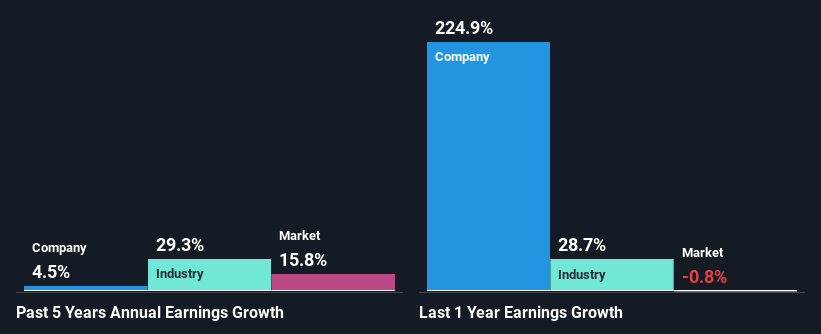VEEM Ltd (ASX:VEE) Is Going Strong But Fundamentals Appear To Be Mixed : Is There A Clear Direction For The Stock?
VEEM (ASX:VEE) has had a great run on the share market with its stock up by a significant 56% over the last month. But the company's key financial indicators appear to be differing across the board and that makes us question whether or not the company's current share price momentum can be maintained. Particularly, we will be paying attention to VEEM's ROE today.
Return on equity or ROE is an important factor to be considered by a shareholder because it tells them how effectively their capital is being reinvested. Simply put, it is used to assess the profitability of a company in relation to its equity capital.
See our latest analysis for VEEM
How Is ROE Calculated?
Return on equity can be calculated by using the formula:
Return on Equity = Net Profit (from continuing operations) ÷ Shareholders' Equity
So, based on the above formula, the ROE for VEEM is:
8.8% = AU$4.1m ÷ AU$47m (Based on the trailing twelve months to June 2023).
The 'return' is the profit over the last twelve months. Another way to think of that is that for every A$1 worth of equity, the company was able to earn A$0.09 in profit.
Why Is ROE Important For Earnings Growth?
We have already established that ROE serves as an efficient profit-generating gauge for a company's future earnings. Based on how much of its profits the company chooses to reinvest or "retain", we are then able to evaluate a company's future ability to generate profits. Generally speaking, other things being equal, firms with a high return on equity and profit retention, have a higher growth rate than firms that don’t share these attributes.
VEEM's Earnings Growth And 8.8% ROE
On the face of it, VEEM's ROE is not much to talk about. However, given that the company's ROE is similar to the average industry ROE of 8.7%, we may spare it some thought. We can see that VEEM has grown at a five year net income growth average rate of 4.5%, which is a bit on the lower side. Bear in mind, the company's ROE is not very high . Hence, this does provide some context to low earnings growth seen by the company.
Next, on comparing with the industry net income growth, we found that VEEM's reported growth was lower than the industry growth of 29% over the last few years, which is not something we like to see.
Earnings growth is an important metric to consider when valuing a stock. What investors need to determine next is if the expected earnings growth, or the lack of it, is already built into the share price. This then helps them determine if the stock is placed for a bright or bleak future. If you're wondering about VEEM's's valuation, check out this gauge of its price-to-earnings ratio, as compared to its industry.
Is VEEM Making Efficient Use Of Its Profits?
Despite having a moderate three-year median payout ratio of 30% (implying that the company retains the remaining 70% of its income), VEEM's earnings growth was quite low. So there could be some other explanation in that regard. For instance, the company's business may be deteriorating.
Moreover, VEEM has been paying dividends for six years, which is a considerable amount of time, suggesting that management must have perceived that the shareholders prefer dividends over earnings growth. Our latest analyst data shows that the future payout ratio of the company over the next three years is expected to be approximately 30%. However, VEEM's ROE is predicted to rise to 13% despite there being no anticipated change in its payout ratio.
Conclusion
Overall, we have mixed feelings about VEEM. Even though it appears to be retaining most of its profits, given the low ROE, investors may not be benefitting from all that reinvestment after all. The low earnings growth suggests our theory correct. Having said that, looking at the current analyst estimates, we found that the company's earnings are expected to gain momentum. To know more about the latest analysts predictions for the company, check out this visualization of analyst forecasts for the company.
Have feedback on this article? Concerned about the content? Get in touch with us directly. Alternatively, email editorial-team (at) simplywallst.com.
This article by Simply Wall St is general in nature. We provide commentary based on historical data and analyst forecasts only using an unbiased methodology and our articles are not intended to be financial advice. It does not constitute a recommendation to buy or sell any stock, and does not take account of your objectives, or your financial situation. We aim to bring you long-term focused analysis driven by fundamental data. Note that our analysis may not factor in the latest price-sensitive company announcements or qualitative material. Simply Wall St has no position in any stocks mentioned.

 Yahoo Finance
Yahoo Finance 
